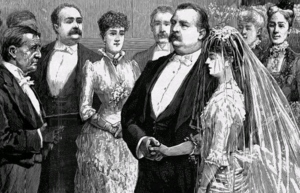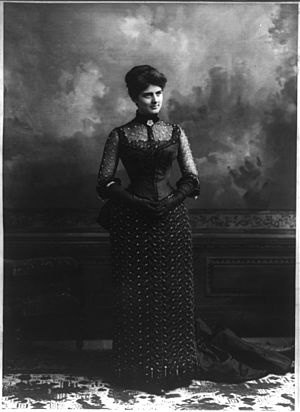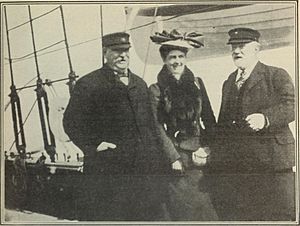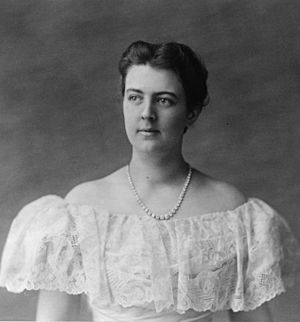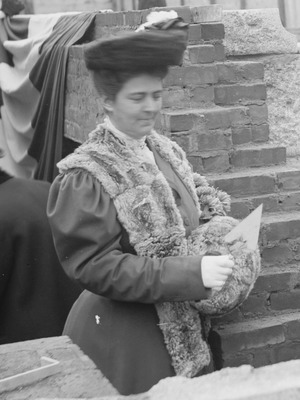Frances Cleveland facts for kids
Quick facts for kids
Frances Cleveland
|
|
|---|---|
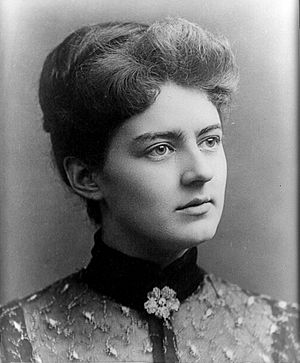
Frances Cleveland c. 1886
|
|
| First Lady of the United States | |
| In role March 4, 1893 – March 4, 1897 |
|
| President | Grover Cleveland |
| Preceded by | Mary McKee (acting) |
| Succeeded by | Ida McKinley |
| In role June 2, 1886 – March 4, 1889 |
|
| President | Grover Cleveland |
| Preceded by | Rose Cleveland (acting) |
| Succeeded by | Caroline Harrison |
| Personal details | |
| Born |
Frances Clara Folsom
July 21, 1864 Buffalo, New York, U.S. |
| Died | October 29, 1947 (aged 83) Baltimore, Maryland, U.S. |
| Resting place | Princeton Cemetery |
| Political party | Democratic |
| Spouses |
Thomas Preston
(m. 1913) |
| Children |
|
| Education | Wells College (BA) |
| Signature | |
Frances Clara Cleveland Preston (born Folsom; July 21, 1864 – October 29, 1947) was the first lady of the United States from 1886 to 1889, and again from 1893 to 1897. She was the wife of President Grover Cleveland. She is the only first lady to have served in this role during two terms that were not back-to-back.
Frances Folsom met Grover Cleveland when she was a baby. He was a close friend of her father. After her father died in 1875, Grover became her unofficial guardian. She went to Wells College and, after graduating, married Grover. He was the president at the time.
When her husband lost the election in 1888, they lived as private citizens for four years and started their family. They returned to the White House when he was elected again in 1892. During her second term, she spent much of her time raising their children.
The Clevelands had five children, and four lived to be adults. Frances was involved in supporting education. She served on the Wells College board, helped women get an education, and helped build kindergartens. After her husband died in 1908, she married Thomas J. Preston Jr. in 1913. She continued her work in education after leaving the White House, working with Princeton University. During World War I, she supported American involvement and prepared the country for war. She died in 1947 and is buried next to her first husband.
Contents
Early Life and Education
Childhood Years
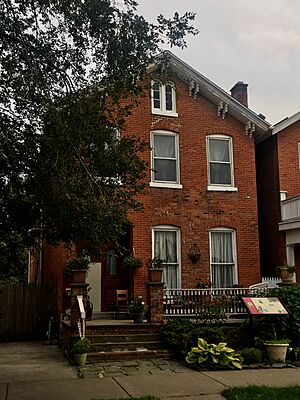
Frances Folsom was born in Buffalo, New York, on July 21, 1864. Her parents were Emma and Oscar Folsom. Her father was a lawyer. Her family came from early English settlers in New England. Frances was the older of two children. Her sister, Nellie Augusta, died when she was a baby in 1872.
Grover Cleveland, who would become her husband, was a close friend of Frances's father. He met Frances when she was a baby and he was 27 years old. He liked her very much, buying her a baby carriage and caring for her as she grew up. Frances went to Madame Brecker's French Kindergarten and then Miss Bissell's School for Young Ladies.
Frances's father died in a carriage accident on July 23, 1875. The court made Cleveland the manager of his estate. He became Frances's unofficial guardian. The Folsom family moved to Medina, New York, to live with Frances's grandmother. They also lived briefly in Saint Paul, Minnesota, with her aunt. Later, they returned to Buffalo and moved to different boardinghouses before finding a home. When she was 14, she joined the Presbyterian Church. She was devoted to her faith throughout her life. As a teenager, she was christened with the name Frank, which she used before her marriage.
Becoming an Adult
Frances Folsom received a very good education for a woman in the 1800s. She attended Medina High School and Central High School in Buffalo. She left school before finishing, but Cleveland, who was then the Mayor of Buffalo, helped her get a certificate. This allowed her to enter Wells College in Aurora, New York, as a sophomore. She quickly became popular at the school.
At Wells, she became interested in photography and political science. She also joined the Phoenix Society debate club. She received three marriage proposals while in college. Cleveland stayed in touch with her, and she called him "Uncle Cleve." He would send her flowers when he was governor of New York and later when he was president. He would visit her at Wells when he could, and she would join him on tours of the state.
Frances could not attend Cleveland's inauguration because of her final exams. But she visited him at the White House during spring break a few weeks later. She was allowed to go up the Washington Monument before it opened. There, she met Harriet Lane, who had been a White House hostess. Lane became her mentor. Frances graduated on June 20, 1885. After graduating, she spent the summer at her grandfather's home. Cleveland proposed marriage to Frances by letter while she was visiting a friend.
When it was decided that Frances would marry the president, she met with Harriet Lane. She learned about the duties of a first lady. After accepting the proposal, Frances traveled to Europe for a year with her mother and cousin. She visited seven countries. Cleveland wanted her to travel and think about her future before marrying. Everyone agreed to keep the wedding a secret. The president's sister, Rose Cleveland, served as White House hostess during this time. People initially thought the rumors of their engagement were just gossip.
By the time Frances returned, reporters were following them. They had to board their ship secretly. The press met them when they arrived in the United States. The rumors seemed true when the president's representatives took them away. The next night, the White House officially announced that the president would marry Frances Folsom. Media attention quickly made Frances a celebrity.
First Lady of the United States
The Wedding Day
The wedding of Grover Cleveland and Frances Folsom happened on June 2, 1886. It took place in the Blue Room of the White House. He was 49, and she was 21. The president and his sister planned the wedding themselves. Reporters were not allowed to attend.
The president wanted a quiet wedding, so only 31 guests were there. However, hundreds of people gathered outside the White House to celebrate. Frances became first lady when she married the president. The Clevelands spent a week in Deer Park, Maryland, for their honeymoon. Reporters followed them closely. After their honeymoon, they held two wedding receptions. One was for diplomats, and one was for the public.
Frances Cleveland was seen as making the president more social. He became more willing to attend events. The president made time in his busy schedule to be with his wife. They went to the theater and took carriage rides. Every evening, they drove to a private home the president had bought. Cleveland did not get involved in the political parts of her husband's job. But she was in charge of their home life. She made sure he rested on Sundays, observing the Christian Sabbath.
First Term in the White House
Frances Cleveland was very popular as first lady. She received a lot of attention from the media and the public. She was the first first lady to have journalists writing only about her activities. She kept a strong public image and was often photographed. Reporters carefully wrote about her travels and activities, which sometimes annoyed the president.
Sometimes, the excitement became dangerous. Large crowds would push to see her, almost knocking people over. The publicity became so big that the Clevelands decided not to live in the White House after their wedding. They moved to their private home, "Red Top," to escape public attention.
While in the White House, Frances Cleveland kept many canaries and mockingbirds. She became good friends with poet Richard Watson Gilder and his wife. She would join them to meet famous writers. Cleveland received hundreds of letters each week, much more than previous first ladies. She started using form letters to reply faster. She also hired her college friend Minnie Alexander as a secretary. She scheduled many social events on Saturdays so working women could attend. She had a close relationship with the White House staff, giving them gifts on their birthdays and Christmas.
In 1887, the Clevelands toured the United States. Frances had a bad insect bite and a black eye. She shook so many hands that she needed an ice pack every day. Their visit to Chicago was attended by 100,000 people. The crowd was so large that Cleveland had to be taken away by aides. Police and soldiers tried to control the crowd. After this, Cleveland avoided such public appearances for the rest of her time as first lady.
Frances Cleveland was not directly involved in politics. However, her popularity helped her husband's administration. Many of the president's political opponents found it harder to criticize him because the first lady was so well-liked. Critics were careful not to attack her. She was even sent to quietly watch a debate in Congress once. Towards the end of the president's first term, opponents started spreading rumors to harm her reputation.
Life Away from the White House
When President Cleveland lost the 1888 election, Frances's time as first lady ended. But she told the staff that they would return the next term. After leaving the White House, the Clevelands sold their Red Top house and moved to Madison Avenue. Frances struggled with the change from public to private life. She had never managed a private home before. She felt sad for several months and went to a friend's cottage. Frances and Grover mostly had separate social lives after leaving the White House.
She found comfort in 1890 when they bought the Gray Gables summer home. Here, the couple created their own private home life. They often hosted close friends.
Between her terms as first lady, Cleveland did charity work. She became more involved in New York social life through her projects. Much of this work supported building free kindergartens in New York. She also helped raise money for Wells College. Cleveland became a mother with the birth of Ruth Cleveland (1891–1904). She dedicated herself to her child.
Grover ran for president again in 1892. Frances's image was often used in his campaign materials, even though he had doubts about it. Her social connections were helpful for the Cleveland campaign in New York. Her charity work and friendships helped them connect with New York society. This helped Grover win his home state, which he had lost in 1888. Still, he did not approve of her involvement in the political parts of his career.
Second Term as First Lady
After her husband's victory, Frances Cleveland became the only first lady to serve two terms that were not consecutive. She was more worried about taking on the role the second time, now knowing all that it involved. After returning to the White House in 1893, her daily life was much like her first term. She insisted on evening drives with the president. She also had her birds and dogs brought back to the White House. Her Saturday receptions returned as well.
She continued her work establishing kindergartens. She also became involved with the Home for Friendless Colored Girls. Cleveland received thousands of letters. She had a typewriter brought to her desk to manage her own communication with the public.
The Clevelands were upset by how much the press and public focused on their daughter Ruth. They decided to close the White House to the public when they were there. Again, they bought a private home outside the White House. However, public harassment did not stop. Cleveland was especially scared by an incident in 1894 when three men were watching their home. Fearing for her children's safety, she had the local police station post a guard at their home. She chose not to worry her husband with the news.
Cleveland became more protective of her husband during his second term. This was a change from their relationship in his first term. The president's work became harder as an economic crisis began. Cleveland worried about her husband. Also, the president's health was declining. His wife became more responsible for his well-being, encouraging him to work less. When it became clear that the president was very ill, she kept his condition a secret. She cared for his health, even though she was pregnant. She made excuses for his absences and wrote letters for him, saying he was just suffering from rheumatism.
Cleveland had two more children as first lady: Esther Cleveland (1893–1980) and Marion Cleveland (1895–1977). Much of her time was spent raising her three children. She would even play on the floor with her children, which surprised the servants. Cleveland also became interested in German culture and the German language during her husband's second term. She learned the language and hired a German nurse so her children would learn it too. She still made time for her duties as hostess, receiving the usual crowds. She also met heads of state. She was not as active in social events, hosting only one in the 1894 social season.
Three thousand people attended the first lady's final Saturday reception to shake her hand. When Cleveland's time as first lady ended, she cried as she left the White House. She personally said goodbye to each staff member. This organized farewell became a tradition for future first ladies. Despite her emotional departure, she later said she was relieved not to be first lady anymore. She remembered the rumors and false stories about her.
Life After the White House
Widowhood and Remarriage
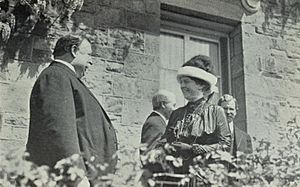
After leaving the White House for the second time, the Clevelands bought a house in Princeton, New Jersey. They had two more children: Richard F. Cleveland (1897–1974) and Francis Cleveland (1903–1995). Their first daughter, Ruth, died of diphtheria in 1904 at their summer home. To avoid sad memories, they sold that home and bought another in Tamworth, New Hampshire. The Clevelands became involved with Princeton University and helped many students there.
Grover Cleveland died in 1908. Frances was left to raise their four children alone. She refused the money she was legally entitled to as a widowed first lady. However, she did accept the franking privilege, which allowed presidential widows to send mail for free.
After her husband's death, she was involved in a legal case against a writer. The writer had been paid for an article supposedly by Cleveland before his death, but it was a fake. In March 1909, she held a memorial for her husband. A trip to Europe with her family helped her grief. Cleveland was invited back to the White House for a dinner in her honor in 1913. The staff who knew her were very excited.
On February 10, 1913, at 48 years old, she married Thomas J. Preston Jr.. He was a professor of archaeology at her old college, Wells College. Like her engagement to Grover, she kept the wedding private to limit media attention. They were invited to the White House by President William Howard Taft to celebrate their engagement. She was the first presidential widow to remarry. After their marriage, they lived in London for almost a year. They traveled Europe regularly after that. Her second husband later taught at Princeton University, where she remained a well-known figure in campus social life.
Later Years and Activism
Frances was offered the position of president of the Daughters of the American Revolution, but she turned it down because of its political duties. She spoke out against women's suffrage, which was the right for women to vote. In May 1913, she was elected vice president of the New Jersey Association Opposed to Woman's Suffrage. She also led the Princeton chapter of the organization.
Cleveland was on vacation in Switzerland with her children when World War I started in August 1914. They returned to the United States in October. Frances and her husband worked with activists and former presidents to promote military preparedness. She joined a pro-war group called the National Security League. She became its director of the Speaker's Bureau and the Committee on Patriotism through Education in November 1918. Even though she had never given speeches as first lady, she did so regularly in this role. Frances and Thomas eventually left the organization. She caused some controversy by saying some Americans were not fully integrated into the country. She resigned from her position in December 1919 due to criticism of her idea for a pro-war education plan.
In 1919, Cleveland helped a writer create the first biography of Grover Cleveland. She contacted everyone who knew Grover to collect his letters for the Library of Congress. In 1922, she led Wells College's fundraising efforts. During the Great Depression in the 1930s, she became president of the Needlework Guild of America. She led its clothing drive for poor people.
Cleveland remained important in political circles during the 1900s. In the 1928 election, she supported Al Smith for president. This was her only political endorsement for someone other than her first husband. She had met the Smiths and was upset by the attacks against him because he was Catholic. Privately, she supported Franklin D. Roosevelt as president and admired Eleanor Roosevelt. She later supported Harry S. Truman. During the Truman presidency, she was invited to a lunch at the White House. There, she met General Dwight D. Eisenhower. Eisenhower reportedly didn't recognize her and asked where in the city she used to live. She replied that she had lived in the White House.
Later in life, she had cataracts, which affected her eyesight. She learned Braille to use a Braille typewriter. She continued to use it even after her cataracts were removed, translating books into Braille for blind children. She was involved with the theater community in her old age. She sometimes traveled with the theater group founded by her son. Her last public appearance was at the Princeton University bicentennial celebration in June 1946. While staying at her son Richard's home for his 50th birthday, Cleveland died in her sleep at age 83 on October 29, 1947. She was buried in Princeton Cemetery next to President Cleveland, her first husband.
Legacy and Influence

Frances Cleveland was a very popular first lady. Her reputation helped shape the role for many years after her time. The social events she hosted were some of the most successful in White House history. Her presence in the White House softened her husband's serious image. It made the president seem like a loving husband, and later, a loving father. In 1887, she was elected to the board of directors of Wells College. She held this position for over 50 years. In her honor, Cleveland Hall was built in 1911 on the Wells College campus. It was originally a library. Today, the building holds classes in foreign language and women's studies. It also has a food bank for those in need. People at the time thought she was one of the greatest first ladies. A 1982 poll ranked her 13th out of 42 first ladies. A 2008 poll placed her 20th out of 38.
Fashion and Public Image
Frances's fashion choices influenced women across the United States. This included her hairstyle, a low bun over a shaved neck. It became known as the á la Cleveland and was widely copied. The press often praised her beauty. The Women's Christian Temperance Union wrote to her, asking her to dress more modestly. They worried she was setting a bad example. She refused to change her style.
Her fashion choices and purchases affected what people bought. Products she used became more popular. One newspaper falsely reported that she no longer bought bustles, which caused their popularity to drop.
Cleveland's huge popularity led to her image being used a lot in advertising. Many products falsely claimed she supported them. It became such a big problem that a bill was proposed in Congress. This bill would have protected people's right to control their image and made it illegal to use someone's image without permission. However, the bill did not pass. Cleveland updated her fashion choices during her husband's second term. She wore tight gowns, feather boas, and large hats, reflecting the styles of the 1890s. News articles continued to mention her beauty and fashion sense even when she was in her seventies.
Political Views and Charity
Cleveland did not publicly support political causes while she was first lady. The Clevelands even spoke out against "Frances Cleveland Influence Clubs" that formed in her name in 1892. Instead, she worked with charity groups. These included the Needlework Guild, which made clothes for the poor. She also helped the Christmas Club and the Colored Christmas Club, which gave gifts to children during the holidays.
She did not comment on the controversial issue of women's suffrage while she was first lady. But she believed that women's education was important for equality. She actively supported schools for women. Cleveland was very interested in the arts. She supported international copyright protections and attended a convention on the topic in 1888. She also provided charity support, helping many aspiring musicians. One exception to Frances Cleveland's avoidance of political activity was her interest in the political situation of the Republic of Hawaii. Frances supported Princess Ka'iulani's claim to the throne.
Cleveland supported the temperance movement, which aimed to reduce alcohol use. She personally donated to the Woman's Christian Temperance Union. However, she did not want to force her beliefs on others. So, she continued to serve wine at White House receptions. Frances supported some women's causes throughout her life, but she was against women getting the right to vote. Like many women against suffrage at that time, she felt that being involved in politics was a duty to be avoided. She thought it risked women's control of the home. However, she did vote in elections after the Nineteenth Amendment was passed, which gave women the right to vote.
See also
 In Spanish: Frances Cleveland para niños
In Spanish: Frances Cleveland para niños
- Philippa Foot – English philosopher and Cleveland's granddaughter


